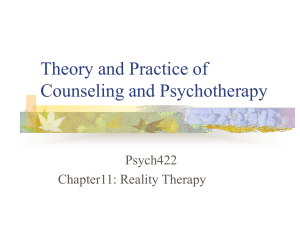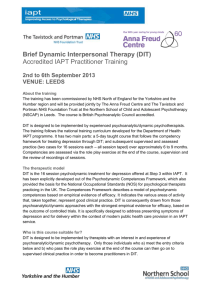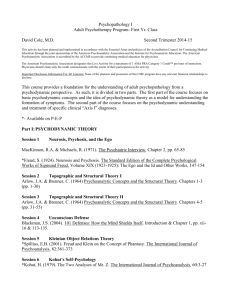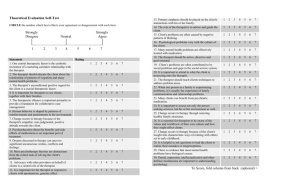The competences required to deliver effective Alessandra Lemma
advertisement
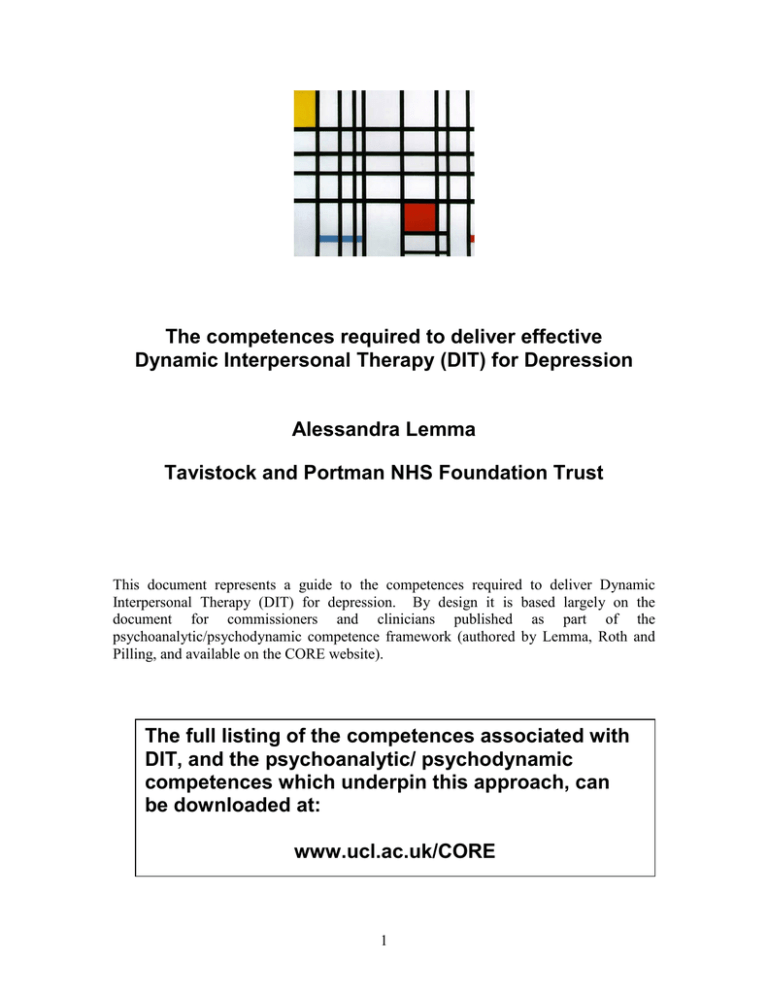
The competences required to deliver effective Dynamic Interpersonal Therapy (DIT) for Depression Alessandra Lemma Tavistock and Portman NHS Foundation Trust This document represents a guide to the competences required to deliver Dynamic Interpersonal Therapy (DIT) for depression. By design it is based largely on the document for commissioners and clinicians published as part of the psychoanalytic/psychodynamic competence framework (authored by Lemma, Roth and Pilling, and available on the CORE website). The full listing of the competences associated with DIT, and the psychoanalytic/ psychodynamic competences which underpin this approach, can be downloaded at: www.ucl.ac.uk/CORE 1 Relationship between Dynamic Interpersonal Therapy (DIT) and the Psychoanalytic/ Psychodynamic competence framework The competence framework for psychoanalytic/psychodynamic therapies sets out the competences associated with psychoanalytic approaches for which there is good research evidence of efficacy. In doing so it clarified the underlying structure of dynamic techniques likely to be effective in routine practice. DIT emerges directly from this work, and is an attempt to outline a brief psychodynamic approach to the treatment of depression which stays close to the evidence-base. Because it draws so closely on the competence framework DIT is grounded in strategies and techniques that will be familiar to practitioners of short-term focal psychodynamic psychotherapies; in that sense it is not novel (and it is worth emphasizing that DIT is not intended to be a further new psychodynamic sub-modality). What is distinctive about DIT is the way in which it structures these elements, making it accessible to clinicians through a treatment and training manual. An overview of DIT DIT is delivered through a brief (16 sessions) protocol that integrates core, shared psychodynamic principles and techniques grounded in the extant evidence base, and thus carries some external or empirical credibility when applied with a specific focus on depression (Lemma et al., in press). DIT has been designed to achieve a practical fit between a psychodynamic approach and the symptom focus of modern commissioners and consumers of psychological therapy services without compromising its theoretical tradition and its unique mechanisms of therapeutic action. While drawing primarily on psychodynamic principles of technique (such as. working in the transference, or the interpretation of defences) DIT is situated at the supportive end of the spectrum of expressive therapies. Its techniques and theoretical underpinnings are not novel and reflect the core knowledge areas highlighted in the psychoanalytic/psychodynamic therapies competence framework. DIT is a protocol that assists psychodynamically trained clinicians to work to a specific dynamic focus relevant to the difficulties commonly encountered by patients with depression. It aims to provide a framework for those who already have basic training in psychodynamic psychotherapy to practice their competencies within a structure created to maximise acceptability to all psychodynamic schools, speedy acquisition of the method and a protocol that optimises compatibility with current NHS practice and permits the ready evaluation of competence, adherence and integrity. As an approach DIT is interpersonal because it focuses squarely on the patient’s relationships, internal and external, as they relate to the problem(s) in the patient’s current life, giving rise to symptoms of depression. An interpersonal focus is shared with several other modalities, not least Interpersonal Therapy (IPT, Weissman et al, 2007), with which (perhaps somewhat confusingly) it shares some of its title. Yet the ‘interpersonal’ in DIT is important because it clearly sets it apart from those dynamic models that focus more on 2 intrapsychic variables. However, IPT does not address internalised object relationships; in contrast DIT systematically focuses on the activation in the present of an internalised, often unconscious, object relationship that is meaningfully linked to the presenting symptoms. It is dynamic in its focus in so far as it is concerned with helping the patient to understand the interplay between external and internal reality as it relates to a problematic circumscribed relational pattern. Consequently it addresses a non-conscious realm of experience, which again distinguishes DIT from IPT, and closely aligns it with other psychodynamic models. Contents of this document Because the psychoanalytic/psychodynamic competence framework forms the underpinning for the competences associated with DIT what follows is largely based on the clinician and commissioners guide developed for psychoanalytic/psychodynamic competence framework. This details the ways in which the competences were developed, and readers who are unfamiliar with the methodology which underpins the competence frameworks should refer to it in order to understand what follows (the document can be downloaded at (www.ucl.ac.uk/clinicalpsychology/CORE/psychodynamic_framework.htm). Specifying the competences needed to deliver Dynamic Interpersonal Therapy Integrating knowledge, skills and attitudes A competent clinician brings together knowledge, skills and attitudes. It is this combination which defines competence; without the ability to integrate these areas practice is likely to be poor. Clinicians need background knowledge relevant to their practice, but it is the ability to draw on and apply this knowledge in clinical situations that marks out competence. Knowledge helps the practitioner understand the rationale for applying their skills, to think not just about how to implement their skills, but also why they are implementing them. Beyond knowledge and skills, the therapist’s attitude and stance to therapy is also critical – not just their attitude to the relationship with the client, but also to the organisation in which therapy is offered, and the many cultural contexts within which the organisation is located (which includes a professional and ethical context, as well as a societal one). All of these need to be held in mind by the therapist, since all have bearing on the capacity to 3 deliver a therapy that is ethical, conforms to professional standards, and which is appropriately adapted to the client’s needs and cultural contexts. The map of DIT competences Using the map The map of DIT therapy competences is shown in Figure 1. It organises the competences into the five domains outlined above and shows the different activities which, taken together, constitute each domain. Each activity is made up of a set of specific competences. The details of these competences are not included in this report; they can be downloaded from the website of the Centre for Outcomes, Research and Effectiveness (CORE) (www.ucl.ac.uk/CORE). The map shows the ways in which the activities fit together and need to be ‘assembled’ in order for practice to be proficient. A commentary on these competences follows. 4 Ability to maintain an analytic attitude Generic therapeutic competences Knowledge and understanding of mental health problems Knowledge of depression Knowledge of, and ability to operate within, professional and ethical guidelines Knowledge of a model of therapy, and the ability to understand and employ the model in practice Ability to work with difference (cultural competence) Ability to engage client Ability to foster and maintain a good therapeutic alliance, and to grasp the client’s perspective and ‘world view’ Ability to work with the emotional content of sessions Basic analytic/dynamic competences Specific analytic/dynamic techniques Knowledge of basic principles and rationale of analytic/dynamic approaches Ability to assess the likely suitability of an analytic/dynamic approach Ability to engage the client in analytic/dynamic therapy Ability to derive an analytic/ dynamic formulation Ability to establish and manage the therapeutic frame and boundaries Ability to make dynamic interpretations Ability to work in the transference Ability to work with the counter-transference Ability to recognise and work with defences Ability to work with unconscious communication Ability to facilitate the exploration of the unconscious dynamics influencing relationships Ability to work through the termination phase of therapy Specific adaptations Dynamic Interpersonal Therapy Metacompetences Generic metacompetences Capacity to use clinical judgment when implementing treatment models Capacity to adapt interventions in response to client feedback Analytic-specific metacompetences Ability to make use of the therapeutic relationship as a vehicle for change Ability to apply the model flexibly in response to the client’s individual needs and context Ability to help the client become aware of unexpressed or unconscious feelings Ability to manage endings Ability to undertake generic assessment (relevant history and identifying suitability for intervention) Ability to establish an appropriate balance between interpretative and supportive work Ability maintain an analytic/dynamic focus Ability to identify and respond to difficulties in the therapeutic relationship Ability to assess and manage risk of self-harm Ability to identify and skillfully apply the most appropriate analytic/dynamic approach Ability to work with both the client’s internal and external reality Ability to use measures to guide therapy and to monitor outcomes Ability to make use of supervision 5 Generic therapeutic competences Knowledge: Knowledge of mental health problems, of professional and ethical guidelines and of the model of therapy being employed forms a basic underpinning to any intervention, not just to psychoanalytic/ psychodynamic therapy. Being able to draw on and apply this knowledge is critical to the delivery of effective therapy. The ability to operate within professional and ethical guidelines encompasses a large set of competences, many of which have already been identified and published elsewhere (for example, profession-specific standards, or national standards (such as the Shared Capabilities (Hope, 2004)) and the suites of National Occupational Standards relevant to mental health (available on the Skills for Health website (www.skillsforhealth.org.uk)). Embedded in these frameworks is the notion of “cultural competence”, or the ability to work with individuals from a diverse range of backgrounds, a skill which is important to highlight because it can directly influence the perceived relevance (and hence the likely efficacy) of an intervention. Building a therapeutic alliance: The next set of competences is concerned with the capacity to build and to maintain a therapeutic relationship. Successfully engaging the client and building a positive therapeutic alliance is associated with better outcomes across all therapies. Just as important is the capacity to manage the end of treatment; which can be difficult for clients and for therapists. Because disengaging from therapy is often as significant as engaging with it, this process is an integral part of the ‘management’ of the therapeutic relationship. Assessment: The ability to make a generic assessment is crucial if the therapist is to begin understanding the difficulties which concern the client. This is a different activity to the focussed assessment described in the problem-specific competence lists or the assessment specific to the likely suitability of an psychoanalytic/ psychodynamic approach. In contrast a generic assessment is intended to gain an overview of the client’s history, their perspectives, their needs and their resources, their motivation for a psychological intervention and (based on the foregoing) a discussion of treatment options. Assessment also includes an appraisal of any risk to the client or to others. This can be a challenging task, especially if the person undertaking the assessment is a junior or relatively inexperienced member of staff. Bearing this in mind, the ability for workers to know the limits of their competence and when to make use of support and supervision, will be crucial. Supervision: Making use of supervision is a generic skill which is pertinent to all practitioners at all levels of seniority, because clinical work is demanding and usually requires complex decision making. Supervision allows practitioners to keep their work on track, and to maintain good practice. Being an effective supervisee is an active process, requiring a capacity to be reflective and open to criticism, willing to learn and willing to consider (and remedy) any gaps in competence which supervision reveals. 6 Ability to maintain an analytic attitude Activities in all domains of psychoanalytic/ psychodynamic therapy competence need to be carried out in the context of an overarching metacompetence: the ability to approach all aspects of the interaction with the client, and of the management of the therapeutic setting, with an “analytic attitude”. The analytic attitude describes the therapist’s ‘position’ or state of mind in relation to the therapeutic task. This stance is characterised by a receptiveness to the client’s unconscious communications and to the unfolding of the transference. The therapist’s state of mind thus functions as “the keeper of the analytic process” (Calef & Weinschel, 1980). Nowadays there is no consensually held notion of shared technique (Gabbard & Westen, 2003), such that even definitions of the analytic attitude are subject to variation across different schools of psychoanalysis. Notwithstanding this point, across the manuals we surveyed, there is consensus about the importance of the therapist being as unobtrusive as possible and of retaining a more neutral, relatively anonymous stance towards the client that prioritises reflection and interpretation over action. Such an attitude, of course, is in itself an intervention because clients will react differently, for example, to the therapist’s interest in the meaning behind the client’s request for advice rather than its provision. The client’s reactions to the therapist then become the focus of exploration and provide opportunities for understanding the transference and the client’s internal world of relationships. Keeping to an interpretative mode conveys to the client, even if painfully, that difficult states of mind can be reflected upon with another person. This way of working has contributed to a caricature of the psychoanalytic/ psychodynamic therapist as aloof and unemotional This caricature is common, and while it may true of some individual therapists, it is by no means true of the majority. It is also unhelpful on at least two counts. If psychoanalytic/ psychodynamic therapy were to be implemented in this way it is unlikely that enduring change would result. And as should be clear from the competence framework described in this report, it would not really be psychoanalytic/ psychodynamic therapy. Striving for ‘neutrality’ and relative anonymity should not result in emotional detachment. The analytic attitude is about a particular way of listening: the therapist empathises with the client’s subjective experience while at the same time being curious about its unconscious meaning, rather than trying to solve problems or give advice. Rather than being aloof, the psychoanalytic/ psychodynamic therapist should be actively engaged and emotionally attuned to the client’s subjective experience: they are a participant in the therapeutic process and will experience strong feelings in response to the client’s communications. However, they also need to be able to stand back from the interaction with the client so as to reflect and comment on it, thereby helping the client gain understanding of how they relate to others. Psychoanalytic/ psychodynamic work requires the therapist’s ability to alternate between the temporary and partial identification of empathy and the return to the position of an observer to the interaction. The therapist therefore requires a well-developed capacity for 7 self-monitoring and self-scrutiny in order to reflect on and modify their responses in the moment. Basic Psychoanalytic/ psychodynamic Therapy competences This domain contains a range of activities that are basic in the sense of being fundamental areas of skill; they represent practices that underpin any psychoanalytic/ psychodynamic therapy intervention. Knowledge of the basic principles of psychoanalytic/ psychodynamic therapies falls into three areas: knowledge of the core principles of psychoanalytic/ psychodynamic therapy, of developmental theory and of a psychoanalytic/ psychodynamic model of the mind. The ability to assess the likely suitability of psychoanalytic/ psychodynamic therapy represents a potential challenge, since we know that pre-therapy client characteristics are not significantly predictive of outcome. Often therapists base their treatment decisions on information gleaned from the ‘live’ experience of the assessment process and on cumulative practice-based evidence of the indications and contra-indications for the approach. Psychoanalytic/ psychodynamic therapy can be applied to a range of clinical problems, and a key task for any assessment is to identify those ways in which the therapy may need to be applied or adapted to meet the needs of the individual client, as well as taking into account the resources available to the therapist (e.g. access to multidisciplinary support). The ability to engage the client in the therapeutic work is fundamental to any approach. In psychoanalytic/ psychodynamic therapy this is achieved by listening attentively and responding non-judgementally to the client’s conscious and unconscious experience. It also requires that early on the therapist provides the client, with an experience of how the therapy works, for example, through maintaining the analytic attitude. The therapist uses their experience of the client’s response to them in order to help identify what adaptations may be necessary to meet the needs of client who may have difficulty engaging with therapy. For example, some clients may have had little, if any, experience of another person helping them to make sense of what they feel, and to begin with the work is often not about uncovering meaning; rather, it is about helping the client to build a relationship within which they can articulate what they feel before they can begin to explore why they feel in a particular way. In order to engage, the client needs to have enough information to make an informed decision about their treatment and to feel that the therapist is willing to discuss this openly with them. It is therefore important that the therapist provides the client with direct information about the approach, including its potential risks. 8 The client will also require a sense of what the therapy can help them with. An important task at this early stage involves working together with the client to identify and agree therapeutic aims. This is particularly important when working within a time-limited frame, because a focus that is felt to be meaningful to the client is more likely to promote engagement The ability to formulate is fundamental to the practice of psychoanalytic/ psychodynamic therapy. A formulation accounts for the developmental origins of the client’s difficulties, the underlying unconscious conflicts, the defences associated with their management and the recurring interpersonal patterns and expectations of others. Clients will have areas where they show a good capacity for functioning as well as areas in which they are vulnerable or have difficulties (i.e. areas of deficit and of conflict), and formulations need to reflect this balance. A formulation helps to bridge theory and practice, and helps ensure that therapy is mapped to the needs of the individual client. Because it is usually shared with the client it gives them a chance to conceptualise their own difficulties, and a chance to appraise the degree of fit between the formulation and their own experiences. If the formulation does not feel right to the client it can be discussed and, if appropriate, revised. This process is important because if it makes sense to the client they are more likely to be engaged with therapy. Establishing and managing the therapeutic frame and boundaries involves a range of activities and interventions, all of which are likely to have meaning for the client. For example, changes to the time of appointments or of the therapy room can be experienced as emotionally charged events for some clients. This is why when changes or deviations occur – and they invariably do – the psychoanalytic/ psychodynamic therapist works with the client to understand the unconscious meaning the deviation has for them and helps the client to link this with the interpersonal dynamics that are being explored in the therapy. Exploration of the client’s experience of the frame and of the boundaries of the therapeutic relationship is therefore of value in helping them to understand themselves and their difficulties . The ability to work with unconscious communication underpins the next two areas of competence, namely facilitating the exploration of unconscious feelings and of the unconscious dynamics influencing relationships. It refers to a particular quality of listening in which the explicit content of the client’s communications is considered to be the “tip of an iceberg” of reference and implication. Therapists need to take what the client is telling them at face value, but also to be attuned to meanings which are inherent or implied. In this sense they are listening to several levels of discourse simultaneously, making this a distinctive and sophisticated skill, Of course, communication would fail if the therapist did not attend to the first level of implication of what the client said to them; an overemphasis on what the client is not explicitly saying can undermine the development of a good therapeutic alliance. 9 The primary means of unconscious communication are the client’s narratives, dreams and their free associations (the spontaneous links they make between ideas). The therapist can facilitate unconscious communication by knowing when to allow silence, so that free associations can emerge. The therapist listens out for recurring affective and interpersonal themes. Listening in this way is not a passive process. It involves actively being with the client, moment-by-moment, and tracking the often subtle changes in their state of mind, this reflects the central importance of the therapist’s receptivity to the client’s unconscious communications. It also points to the fact that it is impossible to listen without also being in some way personally involved an ‘analytic ear’ without involving ourselves. The ability to be self-reflective and to identify the need for consultation and supervision (or further personal therapy, where required), are therefore key competences. The ability to maintain an analytic focus refers to two distinct, but related, activities. Firstly, it underlines that psychoanalytic/ psychodynamic therapy’s primary, overarching focus is on the exploration of the client’s unconscious experience. Essentially this means that all aspects of the work are approached with an analytic attitude. Secondly, it refers to working on a particular dynamic theme or conflict to the relative exclusion of others for the duration of the therapy. This is usually the case in time-limited therapy, where it is essential to negotiate with the client a circumscribed conflict or interpersonal pattern that will provide direction and a boundary for both client and therapist. Because psychoanalytic/ psychodynamic approaches use the therapeutic relationship as the main vehicle for change, the ability to identify and manage difficulties in the therapeutic relationship is an important skill. For example, whether an interpretation is experienced as helpful will be determined, in large part, by the client’s dominant experience of the relationship at that particular moment in time. The therapeutic relationship can suffer the strains of misunderstandings and misattunements. The therapist might also need to stand the test of the client’s hostility or of their mistrust. Such experiences need to be understood and discussed: the therapist’s interest and openness to making sense of these difficulties will set the tone and implicitly model for the client how conflict can be resolved. The therapeutic relationship is strengthened by the experience of difficulties that can be openly discussed and resolved. It is easier for clients to give voice to negative feelings if they trust that the therapist can tolerate their expression without retaliating or trying to minimise their significance. Responding to such feelings requires that the therapist is able to critically scrutinize their own contribution to any difficulties or impasses in the relationship. Psychoanalytic/ psychodynamic approaches prioritise the exploration of the client’s subjective, unconscious experience, and therapists need the ability to work with both the client’s internal and external reality. The internal world is, however, always in a dynamic interaction with the external world. To get as close as possible to the client’s 10 experience it is therefore essential to also take into account the external reality of the client’s life. The therapeutic relationship will also be affected by the perceived differences (e.g. of age, culture) and similarities between the client and therapist. These need to be openly and sensitively explored, not only because these perceptions are often rich in meaning, but also because, left unexplored, they can become the source of misunderstandings between client and therapist and can undermine the therapeutic alliance. Specific Psychoanalytic/ psychodynamic Therapy techniques This domain includes the main techniques employed by psychoanalytic/ psychodynamic therapists - making dynamic interpretations (particularly of the transference), making use of the counter-transference and working with defences. Not all of these would be employed for any one individual, and different technical emphases would be deployed for different problems. Ability to make dynamic interpretations: An interpretation puts into words the client’s conscious and unconscious experience. Often interpretations serve the function of validating the client’s experience; they convey to the client that the therapist has understood their predicament by going one step beyond an acknowledgement of what the client consciously feels. Sometimes an interpretation brings together disparate elements in a way that can be challenging, because it introduces a new perspective on the client’s experience. It is important therefore to create the conditions of safety within which the client can tolerate these challenges, which are a necessary part of the therapeutic enterprise. Interpretations are best seen as hypotheses – they invite the client to consider another perspective, which may or may not fit. This is why an interpretation is usually couched as a tentative statement or question. Although it is a hypothesis, an interpretation can be experienced by the client as an action, that is, as the therapist doing something to the client. For example, an interpretation of unconscious motivations which may lie behind the client’s behaviour could be experienced as the therapist making a critical comment; if this was so it would be experienced as unsettling and unhelpful. Knowing when and what to interpret relies on the therapist’s ongoing assessment of the client’s degree of disturbance and of their shifting states of mind, within a given session and over time. A good interpretation is often simple, to the point and transparent, that is, it shows the client how the therapist arrived at their particular understanding. This is especially important in the early stages of therapy when the client might be unaccustomed to working with the unconscious and may therefore experience an interpretation as ‘plucked out of the blue’ unless it is grounded in the content of what they were talking about in the session. Importantly, this ensures that the therapeutic process is a collaborative one. 11 Ability to work with transference and counter-transference: Psychoanalytic/ psychodynamic therapy is a relational therapy that focuses on helping the client to understand the dynamic factors (e.g. unconscious feelings and fantasies) that shape their behaviour. It is through addressing these factors, and not simply the experiences that have contributed to them, that therapeutic change is thought to occur. The main focus for interpretation is the client’s recurring interpersonal and affective patterns as they manifest themselves in the transference relationship. These interpretations are often referred to as ‘here-and-now’ or transference. Although they can refer to figures from the client’s past, the primary focus in on the relationship with the therapist as it unfolds in the consulting room. This means that the therapist’s focus is usually on the formulation and interpretation of the client’s current experience of themselves in relationship with other people. A transference interpretation makes explicit reference to the client-therapist relationship and is intended to elucidate and encourage an exploration of the client’s conflicts as they are manifest in the relationship. Although the emphasis is not on the client’s past, work in the transference can cast light on this. Understanding the transference is informed by the therapist’s ability to consider the meaning and relevance of their counter-transference, that is, of their emotional reactions to the client. This will involve monitoring their own contribution to the interaction because the quality of the relationship that evolves between the therapist and the client is determined by unconscious forces operating in both. This therefore requires a well-honed capacity to self-monitor and to identify the therapist’s own contribution to enactments. Ability to work with defences: All psychoanalytic/ psychodynamic approaches aim to identify the nature of the client’s anxiety and how they manage this. This will involve the therapist establishing whether the defences are directed internally (to ward off awareness of threatening thoughts and feelings) or externally (for example, avoiding intimacy with others). Often they may serve both functions. A key task for the therapist is to identify how defences manifest themselves in the client’s communications and ways of relating to the therapist and other people. Because defences exist for a good reason the therapist approaches them sensitively, with due respect for the client’s need for the defences, mindful, too, of the possibility of colluding with them. In the therapeutic situation defences often manifest themselves as resistances, that is, as a kind of ‘opposition’ to the therapy. Working with resistance therefore involves helping the client to think about the different, and often conflicting, motivations that lie beneath their wish to seek help. Ability to work through the termination phase of therapy: Finishing therapy in a planned manner is important not only because clients (and often therapists) may have 12 strong feelings about ending, but also because this allows for discussion of how the client will manage on their own and what further help, if any, they might need. This process is aided by ensuring that the likely schedule for sessions is signalled from the outset, and ensuring that there is explicit discussion towards the end of therapy about the conscious and unconscious meaning of the ending for the client. Each client reacts to termination differently but, generally speaking, ending therapy elicits feelings of loss and often mobilises anxiety about separation. These feelings are not always expressed directly and one of the therapist’s tasks is to help the client to articulate their feelings about ending, and to closely monitor and respond to their experience to minimize the likelihood of premature endings or other “enactments”. Specific adaptations of psychoanalytic/ psychodynamic therapy: DIT This domain contains the competence list for DIT. It describes how clinicians can adapt psychodynamic technique to work to a focus within a time-limited format. It draws on both expressive and supportive techniques and is specifically oriented to the treatment of depression. Metacompetences Therapy cannot be delivered in a ‘cook-book’ manner; by analogy, following a recipe is helpful, but it doesn’t necessarily make for a good cook. This domain describes some of the procedural rules (e.g. Bennett-Levy, 2005) which enable therapists to implement therapy in a coherent and informed manner. Technical flexibility - the ability to respond to the individual needs of a client at a given moment in time - is an important hallmark of competent therapists. The interaction of a particular therapist and a particular client also produces dynamics unique to that therapeutic relationship, resulting in context-dependent challenges for the therapist. In other words, in psychotherapy the problems to be addressed can present differently at different times, the contextual meanings of the therapist and the client’s actions change and the therapist is engaged in a highly charged relationship that needs to be managed. What is required therefore are a range of techniques, complex interpersonal skills under the guidance of very sophisticated mental activities. On the whole these are more abstract competences than are described elsewhere, and as a result there is less direct evidence for their importance. Nonetheless, there is clear expert consensus that metacompetences are relevant to effective practice. Most of the list has 13 been extracted from manuals, with some based more on expert consensus1 and some on research-based evidence (for example, “an ability to maintain adherence to a therapy without inappropriate switching between modalities when minor difficulties arise”, or “an ability to implement models flexibly, balancing adherence to a model against the need to attend to any relational issues which present themselves”). The lists are divided into two areas. Generic Metacompetences are common to all therapies, and broadly reflect the ability to implement an intervention in a manner which is flexible and responsive. Psychoanalytic/psychodynamic therapy-specific metacompetences apply to the implementation of therapy in a manner which is consonant with its philosophy, as well as the way in which specific techniques are applied. As is the case in other parts of the model, this division is pragmatically useful, but it is the case that many of the competences described as ‘Therapy -specific’ could easily be adapted and apply to other interventions or techniques. 1 Through discussion and review of metacompetences by the Expert Reference Group 14


